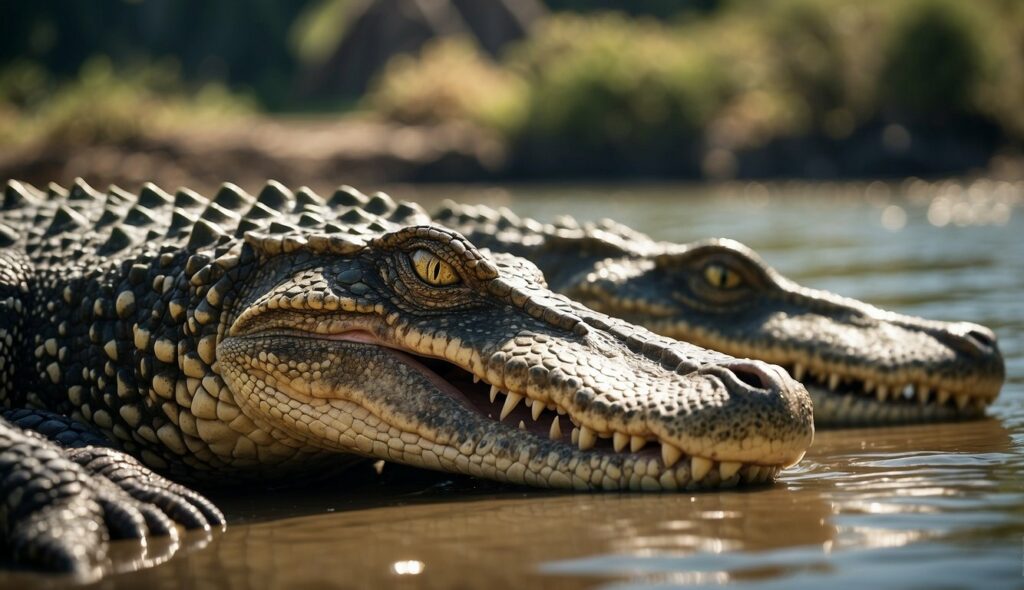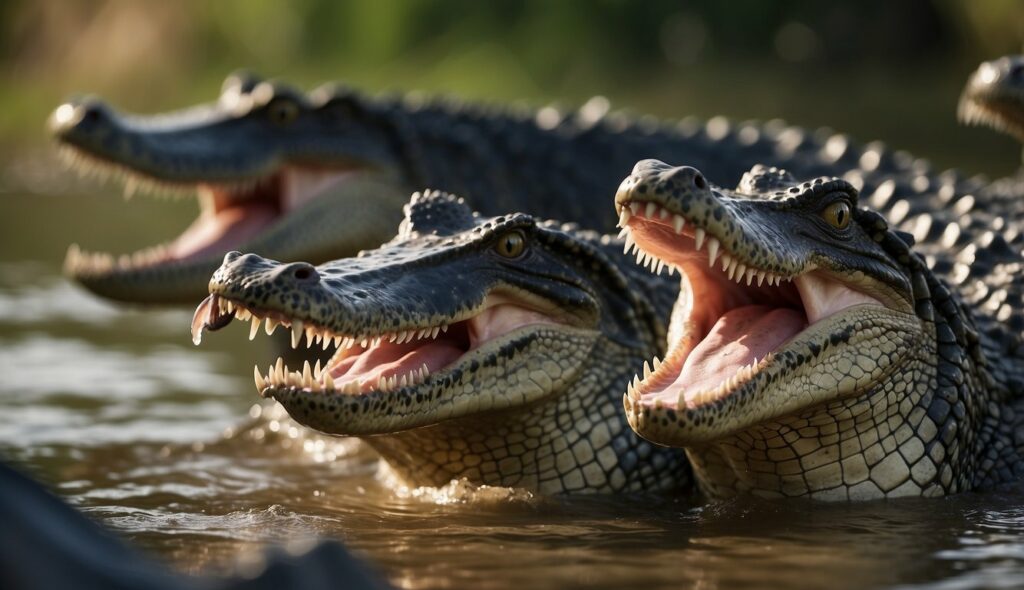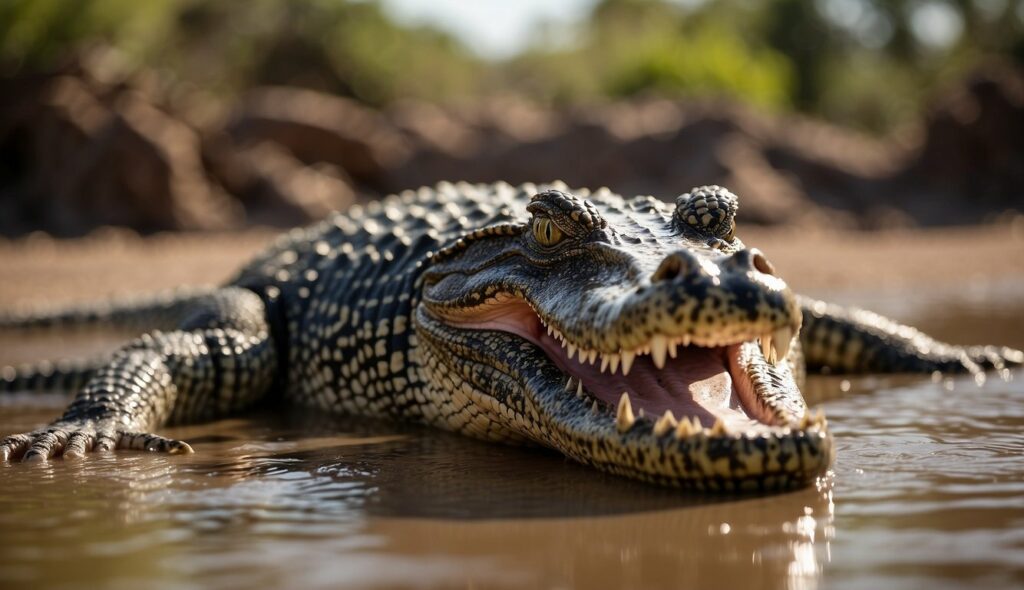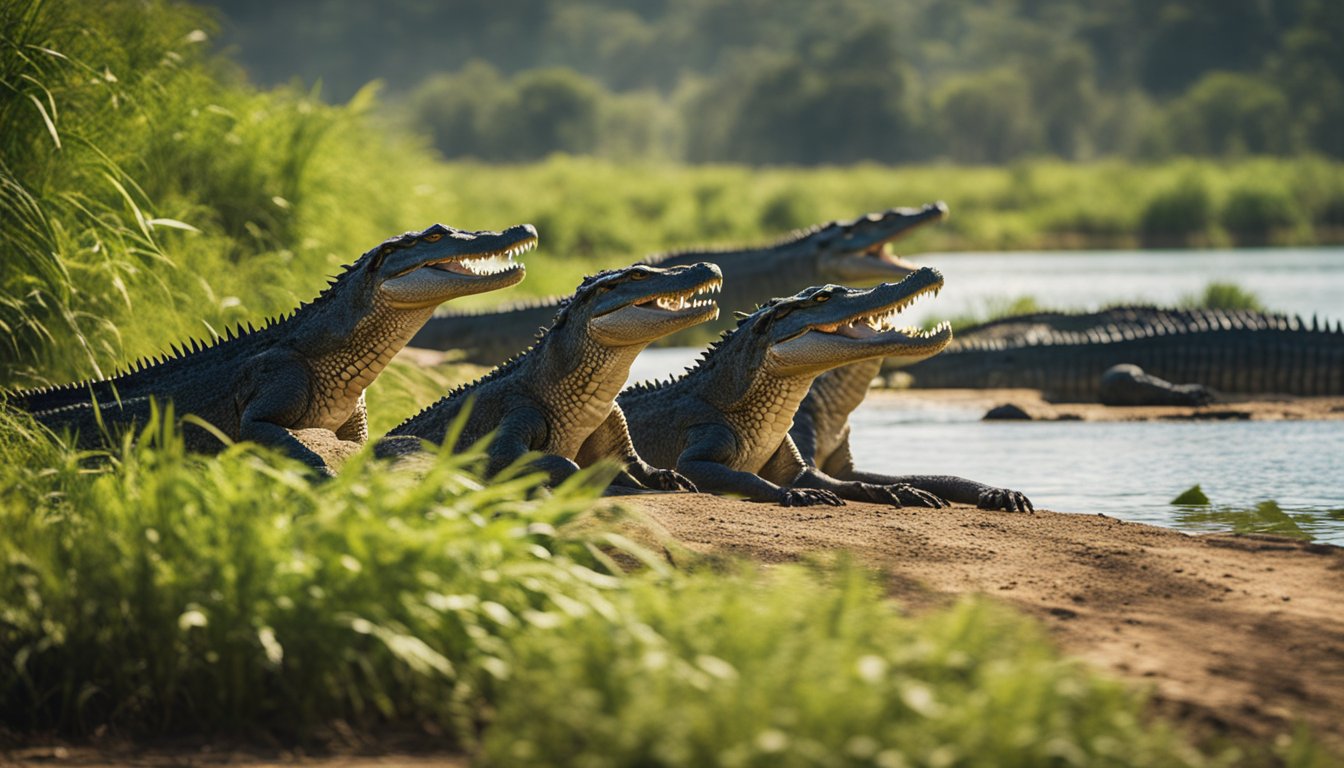Picture the mighty Nile crocodile, a creature that has commanded the rivers and waterways of Africa for millions of years.
These powerful reptiles are like living dinosaurs, and they hold many secrets from a bygone era.
With their thick, tough scales and impressive jaws, Nile crocodiles are the largest crocodilians in Africa, and among the biggest in the world.
They are an awe-inspiring sight for anyone lucky enough to see them basking on a riverbank or gliding through the water with just their eyes and nostrils visible above the surface.

Nile crocodiles are not only fascinating due to their size but also because of their complex behaviors and social structures.
Did you know, for example, that they’re excellent parents?
One might not expect such fierce hunters to be gentle with their young, but these reptiles carefully guard their nests and gently carry their newly hatched babies to the water in their mouths.
As apex predators, they play a critical role in the ecosystems of Africa’s rivers, marshes, and lakes.
They help to keep fish populations healthy and in balance, which affects many other animals and plants in wetland environments.
Through learning about these ancient giants, they come to represent more than themselves; they become ambassadors for the conservation of the wild places they inhabit.
The Mighty Nile Crocodile
As one of the most formidable predators of Africa, the Nile crocodile commands both respect and fascination.
Their existence stretches far back to ancient times, and their physical characteristics and habitats tell a story of adaptation and survival.
An Ancient Lineage
The Nile crocodile is no newcomer to the planet; its lineage dates back about 200 million years.
They’ve been around since the time of the dinosaurs, which is pretty impressive, don’t you think?
It’s as if they’ve stepped right out of a prehistoric world, and yet here they are, thriving in modern times.
Physical Features
Let’s get to know these creatures a bit better by looking at their features.
Adult Nile crocodiles can grow up to 5 meters in length, which is longer than a car!
They tip the scales at a hefty 225 to 500 kilograms.
Their massive jaws are filled with 64 to 68 cone-shaped teeth—perfect for a game of predators and prey in the wild.
And their powerful tails, not only help them swim at speeds of up to 32 kilometers per hour but also aid in taking down prey or fighting off competitors.
Habitat and Distribution
Have you ever wondered where these giant reptiles live? The Nile crocodile makes its home in the freshwater habitats of Sub-Saharan Africa.
They love to lounge in rivers, lakes, and sometimes even marshes. How do they choose their perfect spot?
Well, they need a place with enough food and a comfy temperature.
So, imagine you’re visiting the banks of the Nile River or perhaps taking a safari by Lake Victoria.
Keep your eyes peeled, and you might just spot one of these ancient giants soaking up the sun.
But remember, they’re masters of camouflage—blending perfectly with the muddy waters, waiting patiently for their next meal!
The Life of a Nile Crocodile

Nile crocodiles lead fascinating lives, marked by fierce hunting and intricate growth cycles.
Understanding how they thrive in African rivers and lakes tells us much about their place in the ecosystem.
Diet and Hunting Techniques
The Nile crocodile is a masterful predator, with a diet that emphasizes its position atop the food chain.
Its jaws are capable of a crushing grip, which it uses to capture a variety of prey, including fish, birds, and mammals.
They are known for their tactic of lying in wait, submerged and patient, before ambushing their quarry with lightning speed.
When a wildebeest comes to drink, the crocodile may seize it with those powerful jaws and drag it under, using a death roll to overpower and dismember its catch.
Growth and Reproduction
From the moment they hatch, Nile crocodiles are on a relentless journey of growth.
They start life at around 30 centimeters long, but don’t let their small size fool you; these reptiles can grow up to a formidable 5 meters as adults.
Their growth rate is influenced by factors like food availability and habitat. As for reproduction, these giants exhibit intriguing parental care.
Females lay their eggs in sandy riverbanks, and both male and female crocodiles may guard the nest site.
After a 90-day incubation, the hatchlings call from within the eggs, and the mother helps transport them to water, where their life cycle begins anew.
Imagine being a young crocodile emerging from the egg, the wild African landscape greeting you, an adventure of growth and survival ahead.
The life of a Nile crocodile is a tale of continuous adaptation and learning, with each stage bringing new challenges and opportunities.
Conservation Of The Nile Crocodile

Nile crocodiles are magnificent creatures, but their future hangs in a delicate balance due to the intricate relationship they share with humans and their environment.
What Are The Threats to Their Survival?
Despite their tough exterior and fearsome reputation, Nile crocodiles face several threats that can put their entire species at risk.
Habitat loss is a significant challenge as wetlands are drained for agriculture or human settlement.
As their home shrinks, crocodiles often wander into areas inhabited by people, leading to conflict.
Pollution also plays a part—water sources contaminated with chemicals can be lethal to these sensitive reptiles.
Another problem is illegal hunting.
Crocodile skin is highly valued in the fashion industry, and despite legal protections, poaching remains a serious issue.
Overfishing is also impacting crocodile populations by reducing their food supply, forcing them to compete with fishermen who view them as pests.
Conservation Efforts
To ensure that Nile crocodiles thrive for generations, conservationists are employing various strategies.
Protected areas have been established to safeguard the crocodile’s natural habitats, ensuring a safe place for them to live, hunt, and breed.
Organizations are also working with local communities to promote coexistence.
By setting up crocodile sanctuaries and involving local people in tourism initiatives, the value of living crocodiles can sometimes be greater than that of their skins.
Environmental education plays a critical role too.
Teaching people about the ecological importance of crocodiles helps foster a culture of respect and understanding.
Efforts like these aim to strike a balance where both humans and crocodiles can thrive alongside one another.
Frequently Asked Questions About Nile Crocodiles

In this section, we’ll explore some of the most intriguing questions about Nile crocodiles, revealing their size, unique abilities, mysterious habitats, cultural significance, safety measures, and legendary individuals of their kind.
Each question unravels a part of the crocodile’s fascinating world.
How big can Nile crocodiles get, and was the biggest one ever like a real-life dinosaur?
Nile crocodiles are among the largest of their species, with some adults measuring over 20 feet in length and weighing as much as a small car.
The largest recorded Nile crocodile was around 21 feet long, evoking images of prehistoric times when dinosaur-like creatures roamed the earth.
What kind of superpowers do Nile crocodiles have that help them be amazing hunters?
They have incredible strength, stealth, and senses.
Their powerful jaws can crush bone, and they can hold their breath underwater for up to two hours while stalking prey.
Their eyesight and hearing are finely tuned for detecting even the slightest movement, making them formidable predators.
Why are the crocodiles in the Abanda Cave a different color, and what’s their secret for living in the dark?
The crocodiles in Gabon’s Abanda Caves are a mysterious orange color due to the bat guano they bathe in.
Living in darkness, they’ve adapted to rely less on their vision and more on other senses like touch and hearing to navigate and hunt in their unique environment.
What stories did the ancient Egyptians tell about crocodiles, and did they have a special place in their culture?
Ancient Egyptians were both in awe and fear of Nile crocodiles. They revered the crocodile god Sobek, who represented strength and power.
These creatures were often depicted in Egyptian art and mummies of crocodiles have been found, demonstrating their importance in religion and culture.
When you’re out and about near the Nile, how can you stay safe from crocodile attacks?
Safety around Nile crocodiles involves vigilance and respect for their territory.
Avoid swimming in crocodile-inhabited waters, stay away from riverbanks, and always be on the lookout for these masters of camouflage who may be closer than they appear.
Is the notorious Nile crocodile Gustave still lurking in the waters, and what’s his legendary tale?
Gustave is a legendary Nile crocodile said to be enormous and has been attributed with many attacks.
His exact whereabouts are unknown, but tales of his size and the number of his victims contribute to his fearsome reputation, making him somewhat of a living myth.









